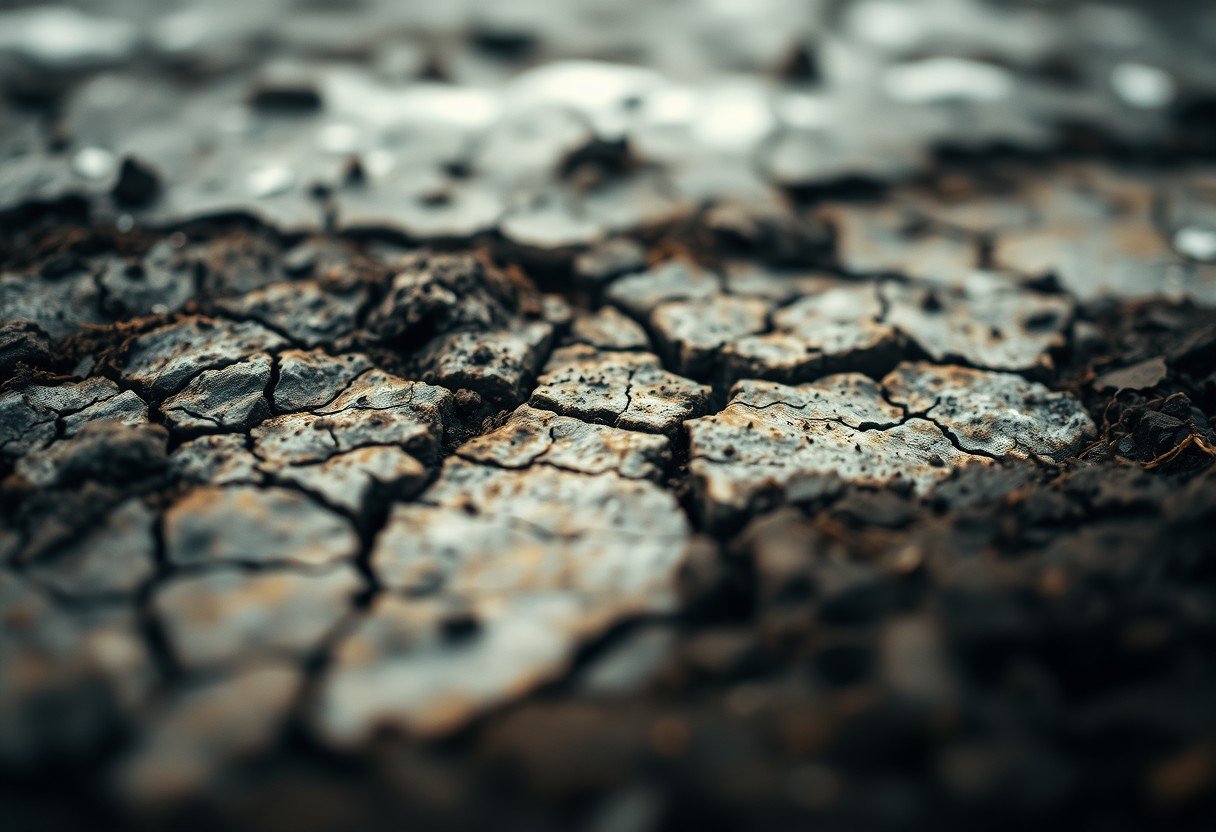Soil creep is the slow, continuous downhill movement of soil, often going unnoticed until it impacts structures or landscapes. This subtle but powerful process is driven by gravity and significantly influenced by environmental cycles like freezing, thawing, wetting, and drying. Understanding how these natural phenomena loosen and move soil is key to managing your property, whether you’re a gardener, homeowner, or builder concerned with long-term stability and erosion control.
What Exactly is Soil Creep?
Think of soil creep as a very slow-motion landslide. It is the gradual, persistent downslope movement of soil and loose rock material under the influence of gravity. Unlike a sudden landslide, soil creep happens at an almost imperceptible rate, often just a few millimeters or centimeters per year.
The primary driver is always gravity, but its effects are amplified by other forces. Changes in temperature and moisture cause the soil to expand and contract, which allows gravity to pull the loosened particles downward with each cycle.
This constant, subtle shifting is what leads to significant changes in the landscape over decades. You might not see it happening, but you can often see its long-term effects on trees, fences, and walls built on a slope.
The Powerful Role of Freeze-Thaw Cycles
In climates with cold winters, the freeze-thaw cycle is a major contributor to soil creep. This process works through a mechanism known as frost heave.
When water in the soil’s pores freezes, it expands by about 9%. This expansion exerts a powerful force, lifting soil particles perpendicular to the slope’s surface. When the ice thaws, the soil particles don’t fall straight back down. Instead, gravity pulls them slightly downslope from their original position.
This cycle repeats over and over throughout the winter and spring. Each time, the soil moves a tiny bit further down the hill. This process weakens the soil’s internal structure by:
- Loosening the bonds between soil particles.
- Increasing the spaces, or pores, within the soil.
- Reducing the overall cohesion and stability of the soil mass.
Over many years, the cumulative effect of these tiny movements results in significant downhill creep.
How Wetting and Drying Contribute to Movement
Even in areas without freezing temperatures, the simple cycle of wetting and drying plays a huge role in soil creep. When soil gets wet from rain, it absorbs water and swells.
This added water has two main effects. First, it increases the weight of the soil, making it more susceptible to gravity. Second, water can act as a lubricant between soil particles, reducing the friction that holds them in place. This is especially true for clay-rich soils, which can absorb a lot of water and become very pliable.
As the soil dries out, it shrinks and often cracks. This process, called desiccation, causes the soil particles to settle and rearrange. Just like with thawing, when the soil settles, it does so under the influence of gravity, leading to a small net movement downhill. This constant swelling and shrinking from wet-dry cycles gradually destabilizes the soil.
Key Factors that Influence the Rate of Soil Creep
The speed and severity of soil creep are not the same everywhere. Several interacting factors determine how quickly soil will move down a slope. The steepness of the slope is one of the most obvious factors; the steeper the hill, the stronger the pull of gravity.
Climate is another critical element. Regions that experience frequent freeze-thaw cycles or distinct wet and dry seasons will see more active soil creep. The type of soil and the amount of vegetation also play significant roles in its stability.
The table below summarizes some of the most important factors.
| Influencing Factor | How It Affects Soil Creep |
|---|---|
| Slope Angle | Steeper slopes increase the force of gravity, accelerating movement. |
| Soil Composition | Clay soils expand and contract more with moisture changes, making them more prone to creep than sandy soils. |
| Water Content | Higher moisture levels add weight and reduce friction between particles. |
| Vegetation Cover | Plant roots can bind soil together and reduce creep, but decaying roots can create voids that weaken it. |
Recognizing the Signs of Soil Creep on Your Property
Because soil creep is so slow, you have to look for its long-term effects to know it’s happening. If you live on or near a slope, you can look for several tell-tale signs that indicate the ground beneath you is slowly moving.
Observing the landscape and man-made structures is the best way to identify this gradual movement. Some of the most common indicators include:
- Fence posts, utility poles, and retaining walls that are tilted downhill.
- Trees with curved trunks that are bent at the base, often called “J-butts” or pistol butts.
- Small, wave-like terraces or ripples running across the surface of a grassy slope.
- Cracks appearing in foundations, roads, or sidewalks on a hillside.
These features develop over many years and are the clearest evidence that soil creep is actively shaping your landscape.
Can You Manage or Mitigate Soil Creep?
Completely stopping a natural process like soil creep is nearly impossible, but you can certainly take steps to manage its effects and reduce its rate. The primary goal of any mitigation strategy is to improve soil stability, most often by controlling water and reinforcing the soil.
Improving drainage is one of the most effective methods. By directing water away from the slope with gutters, downspouts, and French drains, you can prevent the soil from becoming overly saturated, which reduces its weight and helps maintain its strength.
Planting vegetation, especially native plants with deep, fibrous root systems, is another excellent strategy. These roots act like a natural net, binding soil particles together and increasing the soil’s resistance to movement. For more severe issues, an engineered retaining wall, designed by a professional, may be necessary to hold back the soil.
If you notice significant signs of movement or damage to your property, it is always best to consult a geotechnical engineer for a professional assessment.
Frequently Asked Questions about Soil Creep
What is the main cause of soil creep?
The main cause is gravity acting on loose soil on a slope. This process is significantly helped by environmental cycles like freezing-thawing and wetting-drying, which repeatedly loosen and shift soil particles.
How fast does soil creep happen?
Soil creep is an extremely slow process, with movement rates typically ranging from a few millimeters to a couple of centimeters per year. This is why its effects are only noticeable over many years or decades.
Is soil creep the same as a landslide?
No, they are different. Soil creep is a slow, continuous movement, whereas a landslide is a rapid, sudden failure of a slope. While both are driven by gravity, their speed and mechanism are very distinct.
Can plants stop soil creep?
Plants can significantly reduce the rate of soil creep. Their root systems help bind soil particles together, increasing the soil’s shear strength and making it more resistant to movement. However, they may not stop it completely on very steep or unstable slopes.
How do freeze-thaw cycles specifically cause soil movement?
When water in the soil freezes, it expands and lifts soil particles up. When the ice thaws, gravity pulls these loosened particles slightly downslope as they settle, resulting in a net downhill movement over time.
Why is soil creep a concern for homeowners?
Over time, the slow movement from soil creep can put pressure on a home’s foundation, retaining walls, and driveways, leading to cracks and structural damage. It can also cause fences and utility poles to tilt, requiring costly repairs.









Leave a Comment